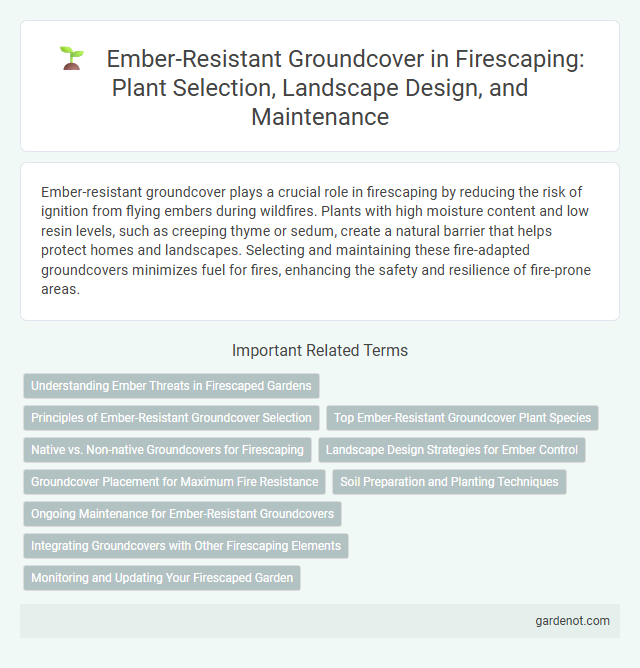Ember-resistant groundcover plays a crucial role in firescaping by reducing the risk of ignition from flying embers during wildfires. Plants with high moisture content and low resin levels, such as creeping thyme or sedum, create a natural barrier that helps protect homes and landscapes. Selecting and maintaining these fire-adapted groundcovers minimizes fuel for fires, enhancing the safety and resilience of fire-prone areas.
Understanding Ember Threats in Firescaped Gardens
Ember-resistant groundcover plays a crucial role in mitigating fire risks in firescaped gardens by reducing the likelihood of ignition from airborne embers. Choosing plants with low resin and oil content, high moisture retention, and dense growth patterns helps create a protective barrier against ember attacks. Properly installed ember-resistant groundcover combined with non-combustible materials significantly enhances garden resilience during wildfires.
Principles of Ember-Resistant Groundcover Selection
Ember-resistant groundcover selection prioritizes non-combustible, low-flammability species such as succulents and moist, low-growing plants that minimize fire spread risk. Soil moisture retention and dense foliage structure reduce ignition probability by trapping embers and maintaining higher humidity content. Proper spacing between plants and maintenance of cleared debris further enhance fire resistance in landscape design.
Top Ember-Resistant Groundcover Plant Species
Ember-resistant groundcover plant species such as creeping thyme, ice plant, and sedum provide effective fire mitigation by reducing combustible materials near structures. These plants possess low resin content and retain moisture, which helps prevent fire spread from embers and radiant heat. Incorporating top ember-resistant groundcover enhances defensible space and improves landscape resilience in fire-prone areas.
Native vs. Non-native Groundcovers for Firescaping
Native groundcovers such as creeping myrtle and bearberry offer natural fire resistance and are well-adapted to local climate conditions, reducing the risk of ember ignition in firescaping zones. Non-native groundcovers like ice plant may be less fire-resistant and can sometimes increase fire hazards due to higher resin or oil content. Selecting native, low-flammability groundcovers supports ember resistance and enhances landscape resilience in wildfire-prone areas.
Landscape Design Strategies for Ember Control
Ember-resistant groundcovers such as creeping thyme, sedum, and ice plant create a low-fuel landscape that significantly reduces fire risk by limiting combustible material near structures. Integrating these drought-tolerant, fire-resistant plants into landscape design acts as a natural ember barrier, preventing embers from igniting flammable debris. Strategic placement of ember-resistant groundcover beneath trees and around patios enhances ember control by minimizing ignition points within high-risk zones.
Groundcover Placement for Maximum Fire Resistance
Strategic groundcover placement significantly enhances ember resistance by creating defensible space around structures. Opt for low-flammability plants such as sedum, creeping thyme, and ice plant, placing them in zones closest to buildings to minimize fuel sources. Maintaining appropriate spacing between groundcovers and integrating non-combustible materials like gravel or stone pathways further reduces fire spread and ember ignition risks.
Soil Preparation and Planting Techniques
Ember-resistant groundcover thrives with well-prepared soil that is deeply tilled and enriched with organic compost to enhance moisture retention and root establishment. Proper planting techniques include spacing plants adequately to reduce fire spread, using slow-release fertilizers to promote healthy growth, and mulching around the base to suppress weeds while maintaining soil hydration. Selecting drought-tolerant, low-flammability species ensures that groundcover remains resilient against ember attack in high-risk fire environments.
Ongoing Maintenance for Ember-Resistant Groundcovers
Routine inspection and removal of dead leaves, dry debris, and fallen branches from ember-resistant groundcovers are essential to maintain their fire-resistant properties. Regular irrigation ensures that plants retain moisture, reducing the likelihood of ignition from airborne embers during wildfire events. Pruning to prevent overgrowth and maintain spacing between plants further minimizes fuel continuity, enhancing the effectiveness of ember-resistant landscaping.
Integrating Groundcovers with Other Firescaping Elements
Ember-resistant groundcovers such as creeping thyme, sedum, and native grasses create a low-flammability barrier that reduces ember ignition near structures. Integrating these groundcovers with hardscaping elements like stone pathways and gravel beds enhances fire breaks while maintaining landscape aesthetics. Combining moisture-retentive plants and non-combustible mulches further minimizes fuel load and improves overall fire resilience in firescaping design.
Monitoring and Updating Your Firescaped Garden
Regularly inspect ember-resistant groundcovers such as native sedums, creeping thyme, and ice plant to ensure healthy growth and effective fire mitigation. Remove any dead or dry foliage promptly to reduce fuel loads and maintain clear spaces around structures. Update your firescaped garden by replacing any damaged or invasive species with fire-resistant plants, ensuring continuous protection against ember storms.
Ember-resistant groundcover Infographic

 gardenot.com
gardenot.com